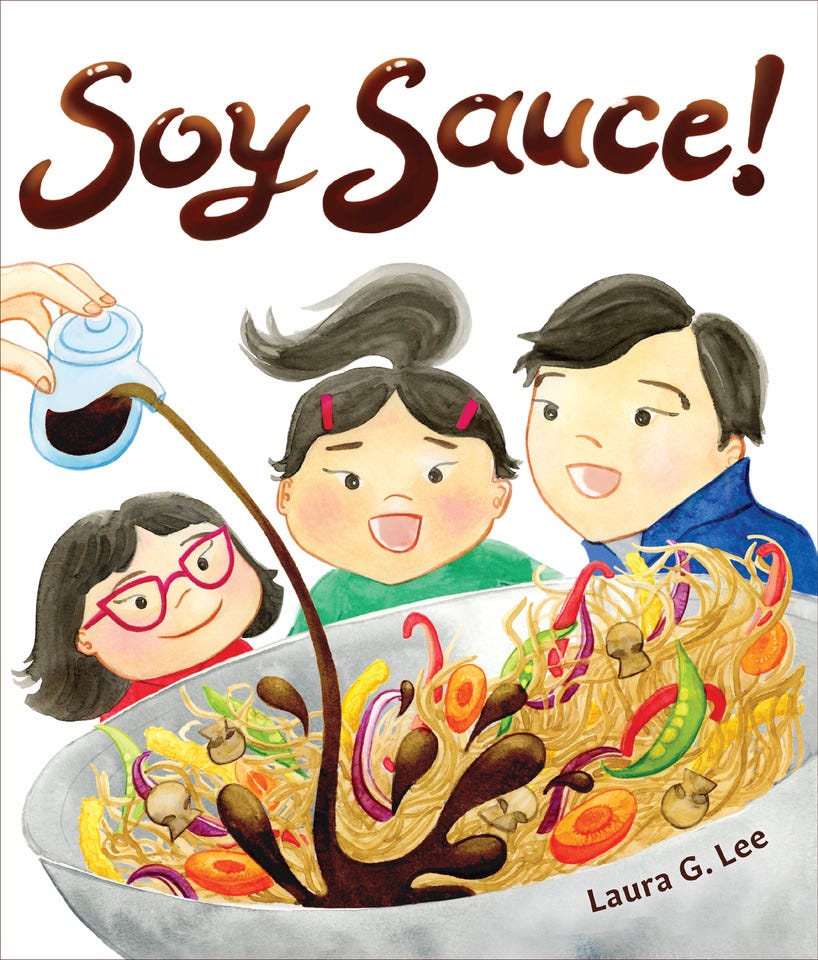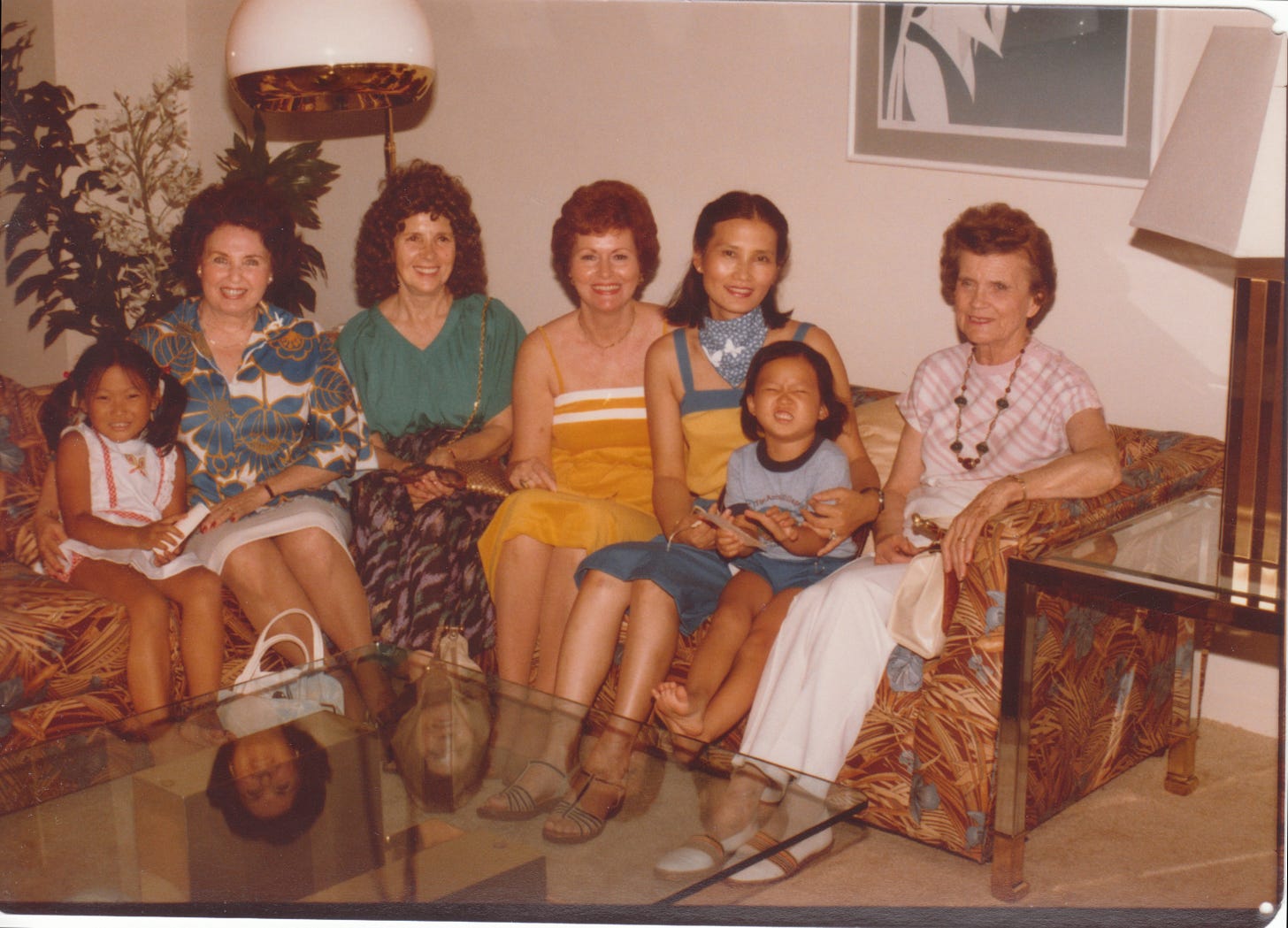Welcome to the first edition of THE CLEVER SEED, a quarterly newsletter where I explore inspiration and creativity in everyday life. As a writer and illustrator of children’s books—and a former design researcher—I’m fascinated by why humans tell stories and what makes creative minds tick.
After decades of digital scrolling, and fatigue with byte-sized comments, I've come to a realization. I miss reading. I miss letters. Long letters, creased by hands and smudged with graphite. Carefully-constructed thoughts sent from other human beings that feel intimate, and weighty. I sincerely hope to tap into the letter-writing vibe, so here I go... I hope you enjoy the ride.
2023, MY YEAR OF SOY SAUCE
Cover of SOY SAUCE! by Laura G. Lee, coming from Hachette Publishing Group in January 2025
After a year of writing and painting in my San Mateo-based studio to craft my upcoming picture book, SOY SAUCE! (coming in January 2025 from Hachette Publishing Group- you can preorder now), I finally took a step back to take in some crisp fall air and ponder, why did I create a book about soy sauce?
I had to travel far back.
My thoughts returned to my years growing up in West Virginia in the 1980s, a place where 'soy sauce' felt synonymous with 'Asian,' and what that meant to me. I remembered feeling like an outsider the day I realized not everyone poured soy sauce on their scrambled eggs, and the grossed-out look on my best friend's face. (After which, I asked my mom to only pack me sandwiches for lunch each day.)
On the flip side, I recalled how my mom secretly added soy sauce to 'American' dishes to give them a kick, and how none of the neighbors could pinpoint why her spaghetti bolognese was so so delicious. I remembered how on warm summer nights, kids playing in the neighborhood outside reserved a special sigh for that amazing barbeque aroma (soy sauce-seasoned bulgogi) wafting from our family kitchen into firefly-lit streets.
Celebrating a birthday at the family table, in Charleston, WV.
My sister, mother, and me with our friends and neighbors.
Raising their daughters in a primarily non-Asian community, my parents chose a path that many first generation immigrants of the 1960s chose to assimilate to Western culture. By age 4, I only spoke English at home. While my parents tried wholeheartedly to embrace a Western way of life, they yearned for home in the food they made, cherishing Korean home cooking (when they could get it) and inventing substitutions for ingredients like gochujang when the nearest Korean market was two states away. As much as they accepted Western foods, their culinary history was a part of them and through our daily life, a part of me.
Food has always been a deep source of connection to my Korean heritage, even when I felt most isolated from it. As I grew up and became more accepting of myself and my identity, I realized how powerful family food can be. I wrote SOY SAUCE! as a way to build a bridge to my own cultural identity, but also between cultures. In a world filled with differences, SOY SAUCE! celebrates what weaves us together– a good family meal shared around the dinner table– all around the globe.
BEGINNINGS
Early days concepting SOY SAUCE!, from manuscript to sketches.
As a writer researching soy sauce, my first step was immersing myself in its fascinating history. Invented over 2000 years ago, soy sauce was carried across the globe through trade and migration. I was surprised to read how it was served in 1600s France at the banquets of Louis the XIV, and how it was likely a secret ingredient for England's very 'English' Worchestershire sauce in the 1800s. I discovered how soy sauce found its way into family recipes of 'native' cuisines like Russian beef stroganoff, Peruvian lomo saltado, and Cajun gumbo. My elementary school self would have been floored to discover how much soy sauce– a wildly popular ingredient now consumed around the world–is truly loved by all.
But not all soy sauces are created equal. The more I discovered, it became clear there was a massive difference between the machine-milled, pillowy packets I got from takeout, and soy sauce brewed using the traditional methods.
As I explored the difference between the production of industrialized and traditionally-brewed soy sauce, one variable stood out as the most significant: time. In industrial soy sauce making, chemicals added during production speed up the process of fermentation so greater amounts of soy sauce can be made, packaged, and sold. But speed comes at the expense of flavor. Flavors are flat, less complex–like a memory that doesn't quite take shape.
Jeong Kwan at work in her kitchen.
Master soy sauce makers, on the other hand, take great pride in the time it takes to make good soy sauce. Legendary chefs like Jeong Kwan, the Korean Buddhist nun and chef (featured in Chef's Table), approach the creation of soy sauce with a deep mindfulness, and appreciation for the patience needed for traditional brewing: “there are sauces aged five years, ten years, aged for one hundred years... passed down for generations." The more time it takes, no doubt, the better the flavor.
In Korea, there is even a tradition of gifting soy sauce at weddings for a future child– as an act of faith in the future. Jeong meditates on the interconnectedness of past and future in the making of hand-crafted soy sauce:
"If you look into yourself, you see past, present, and future... By looking into myself, I see my grandmother, my mother, the elders in the temple, and me. By making soy sauce, I am reliving the wisdom of my ancestors. I am reliving them."
Traditional soy sauce making is an art that preserves more than just taste- but family, identity and home. A bottle of soy sauce, sealed over time with a maker's hopes and dreams, is an extension of their love.
As I envisioned my story, I imagined a mother, washing a bowl of smooth soybeans under cool water before placing them into a steaming pot. I pictured a father and child, mashing a tactile mix of soy paste to form blocks of meju, left outside to dry in sun and wind. I saw loving siblings tending to fermenting pots of soybeans every day, opening their lids to bring in fresh air as they played in a nearby yard. I imagined a grandfather teaching his grandchild how to stir soybeans into fermenting moromi in dark, wooden barrels cherished by his own father and father before him. As the earth continues to travel around the sun, flavors deepen. Snow falls. Years pass.
Haru, Yoo-mi, and Luan exploring a forest of fermenting koji, in SOY SAUCE!
When I read about the owner of Nanyang Sauce Factory, a family-run soy sauce brewery in Singapore, I was touched by this notion of soy sauce as a family memory. Ken, the exuberant successor of his family factory, poignantly describes what it means to 'bottle up time':
"I have many customers, and they tell me, my kid loves your sauce. And I said, 'how do you know?' 'Because whenever I use your sauce, she finishes her meal." I'm like, THAT'S IT. They will never be able to find the same taste anywhere outside. So when they grow up, they will always come home for dinner.... And I thought that was SO beautiful... for me, soy sauce is a bonding thing, and to this day we still keep that family bond."
Food memories, like all salient life moments, can turn back time the minute you take a bite of your mom's home cooking, or taste the alchemical blend of chicken broth and Chinese greens in your dad's Sunday hotpot stew. We treasure and write down recipes of our families with a belief that we can bring their memories of love to life, and cling onto them through an unknowable future. We travel with them millions of miles, hundreds of years.
Then one morning, we wake up and recreate that treasured family dish. And suddenly we are transported home again, the balmy West Virginia breeze flowing through the kitchen, with the ones you love, warm by your side.
A BOOK IS A SEED
"To plant a garden is to believe in tomorrow."
— Audrey Hepburn, actress and humanitarian
I recently stumbled upon this quote as I've been piecing together community outreach ideas for SOY SAUCE!, and I thought to myself, in a world filled with challenges, what makes us plant a garden? Why do we create our stories? Acts of creation– whether they are bottles of soy sauce, family dinners, or children's books– are symbols of hope and belief in tomorrow.
Just as Jeong Kwan reflects on her soy sauce-making as a connection between the past, present, and future, I believe storytelling is an enduring link to our shared humanity—the act of planting seeds that to grow in the minds and hearts of future generations.
Thank you for joining me on this journey.
Until next time,
Laura G. Lee
http://www.lauragleestudio.com
IG: @lauragleestudio








Congratulations on SOY SAUCE! my friend! I so loved learning more about the journey of your picture book story, and to see you and your family in those precious photos. It's fascinating to learn of how long soy sauce must age..it reminds me a bit of balsamic vinegar, and to think about how long things must age, and how families are connected through food, drink, and beloved sauces! I can't wait to add your PB to my collection and look forward to celebrating it's arrival! This is a wonderful newsletter and I look forward to future posts!
Nice Laura! Wish you the very best!